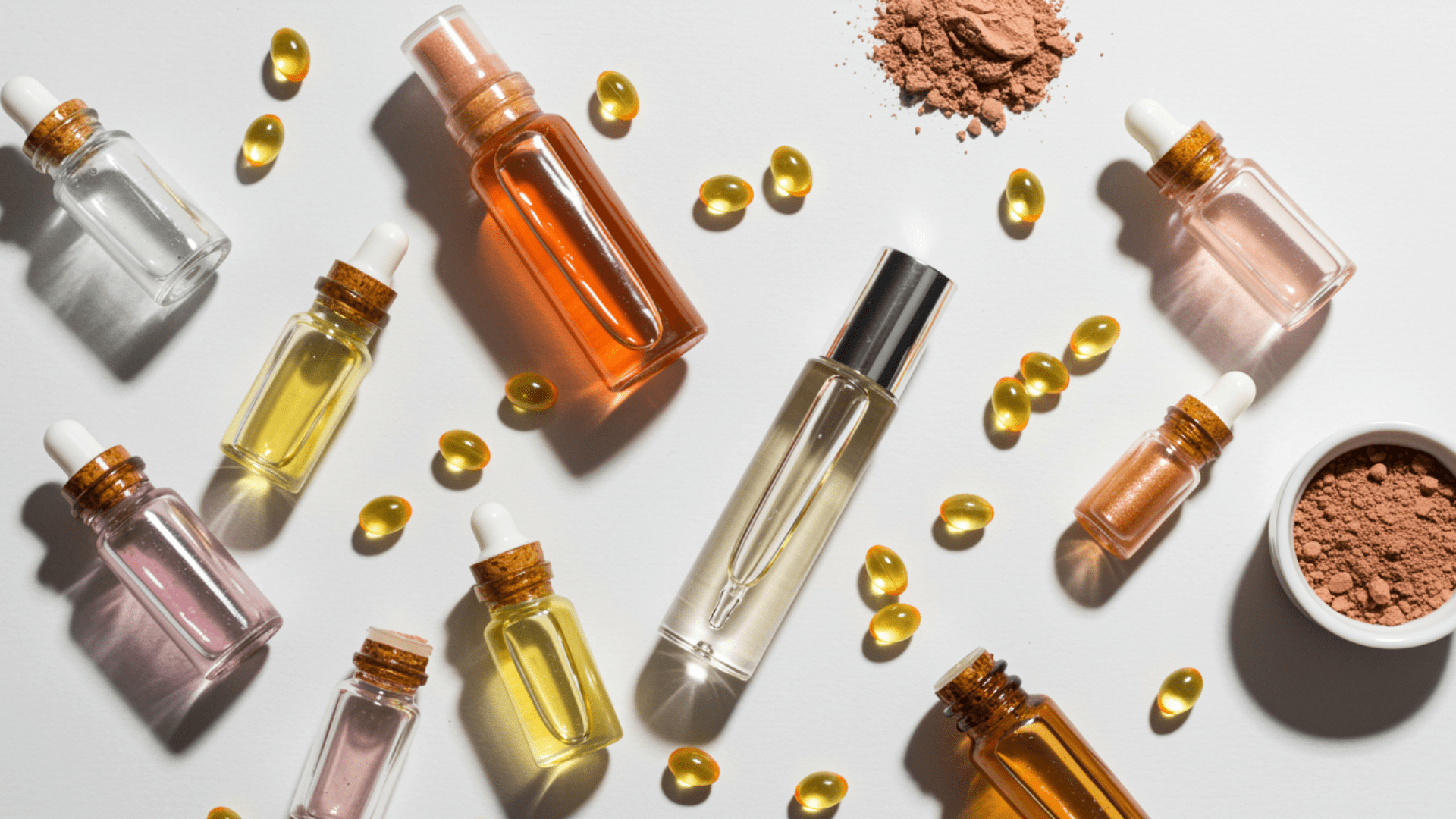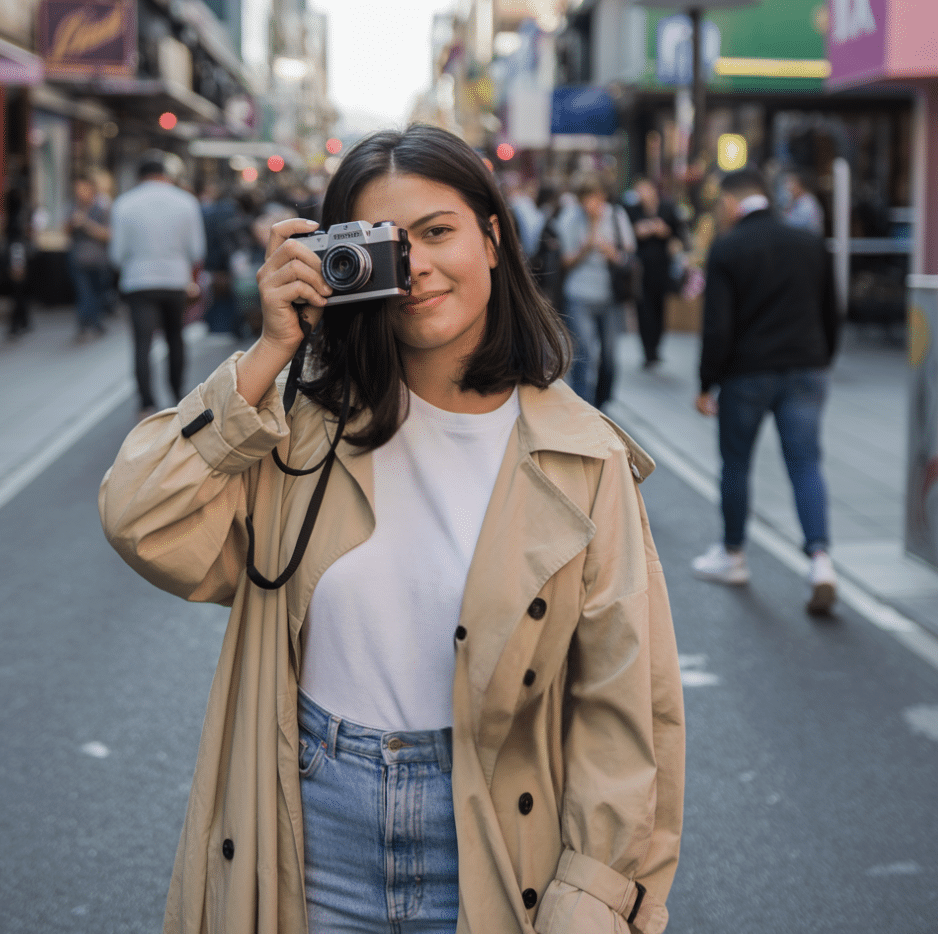Want to achieve that perfect glossy pout without the sticky feeling?
Lip oil might just be your new beauty essential. Unlike waxy balms, lip oils blend nourishing plant oils into a lightweight formula that hydrates while adding natural shine.
With just a few key ingredients, such as jojoba, castor, and squalane, it’s possible to create a custom formula that rivals expensive store-bought versions.
In this guide, I’ll walk you through everything you need to know about how to make lip oil, from the basics of how they work to mixing your own personalized blend that keeps your lips soft, shiny, and healthy.
What is Lip Oil: The Basic Overview
Lip oil represents a modern approach to lip care that bridges the gap between skincare and makeup.
At its core, lip oil is a lightweight cosmetic product made primarily from nourishing plant-based oils, designed to hydrate lips while providing a natural, glossy finish.
Unlike traditional lip balms that use wax bases, lip oils are formulated with smaller molecules that penetrate the delicate lip skin more effectively.
These oils mimic natural sebum, making them incredibly compatible with your lip’s moisture barrier.
Key benefits include hydration lock technology, which allows oils to absorb into the lip tissue for long-lasting moisture from within. The lightweight shine provides a glossy finish without sticky residue, perfect for everyday wear.
Nourishing oils continually improve lip health by conditioning and repairing damaged tissue, unlike traditional products that only mask dryness.
Step-by-Step Guide for Making Lip Oil at Home
Learning how to make lip oil at home is simple and rewarding, but following each step carefully ensures the product is safe, smooth, and effective.
Ingredients and Measurements
Basic Hydrating Lip Oil Formula for approximately 10g / ~10ml.
| Ingredient | % Used | Weight (g) | Function / Notes |
|---|---|---|---|
| Jojoba oil | 35% | 3.5 g | Light, skin-like feel; balances the blend |
| Castor oil | 30% | 3.0 g | Adds shine + slight thickness |
| Squalane | 20% | 2.0 g | Non-greasy slip; lightweight texture |
| Meadowfoam seed oil | 13.5% | 1.35 g | Stability + cushiony feel |
| Vitamin E (mixed tocopherols) | 1% | 0.10 g | Antioxidant: extends shelf life |
| Lip-safe flavor oil (optional) | 0.5% | 0.05 g | ~1–2 drops; adds taste/scent (optional) |
Tip for drop measurements: Roughly 20 drops ≈ 1 g for many cosmetic oils. For flavor oils, start with just 1 drop to avoid overpowering the formula.
Step 1: Sanitize Everything
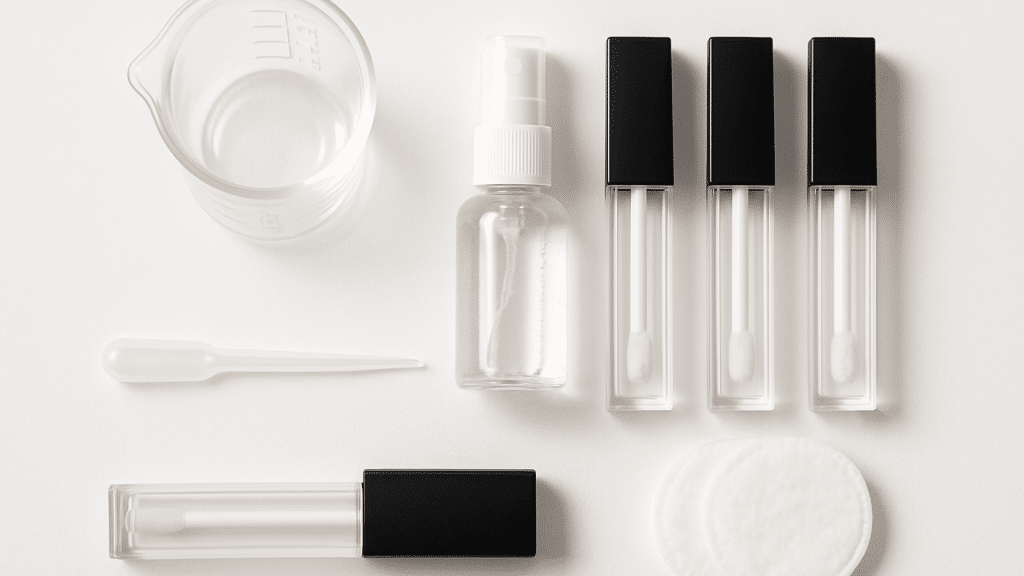
Cleanliness is crucial when making DIY cosmetics. Wipe down the gloss tube, cap, beaker, pipette, and stirring tools with 70% isopropyl alcohol. Let them air dry completely before use.
This helps prevent bacterial growth, ensures a longer shelf life, and keeps your lip oil safe to apply.
Step 2: Mix Base Oils
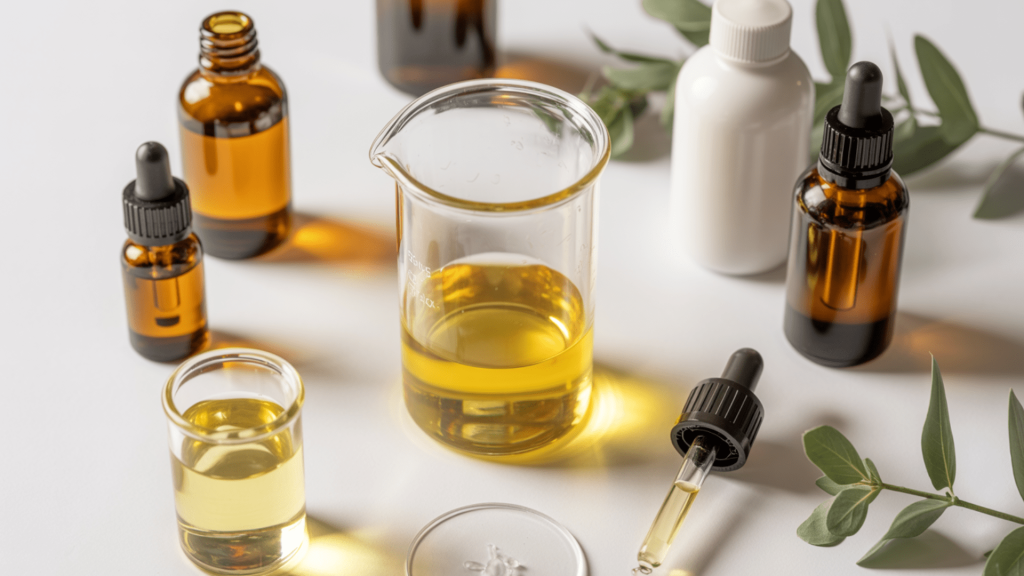
Measure the chosen oils (jojoba, castor, squalane, meadowfoam) into a sanitized beaker. Each oil contributes different qualities, including shine, slip, thickness, and stability.
Stir gently with a sanitized spatula until the mixture looks uniform. This step creates the smooth foundation that determines how the lip oil will feel.
Step 3: Add Antioxidants and Flavor
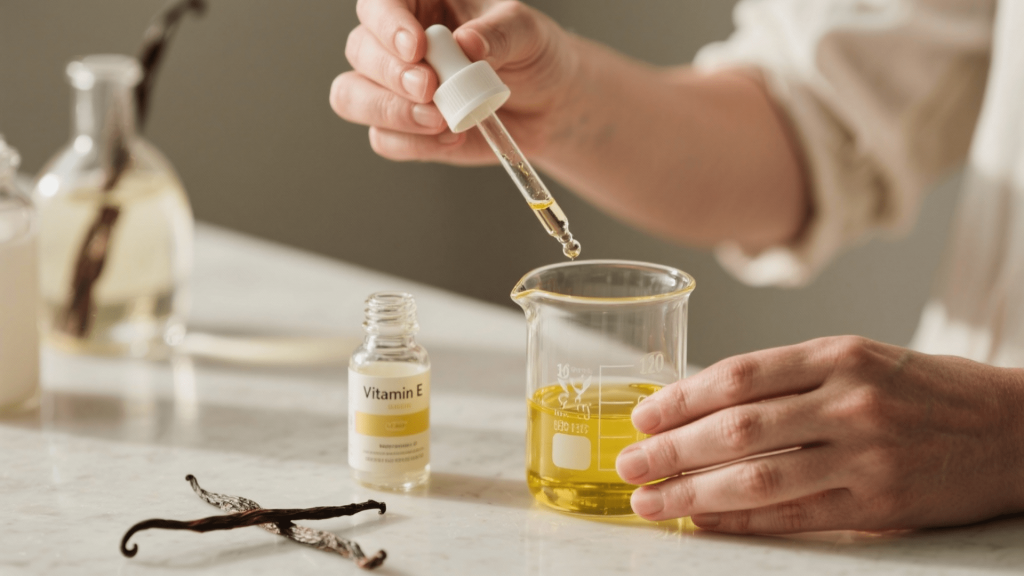
Once the base oils are blended, mix in 1% Vitamin E to slow down oxidation and keep oils fresher for longer.
If desired, add a small amount of lip-safe flavor oil (like vanilla or strawberry). Stir thoroughly so the additions distribute evenly throughout the blend.
Step 4: Optional Tint
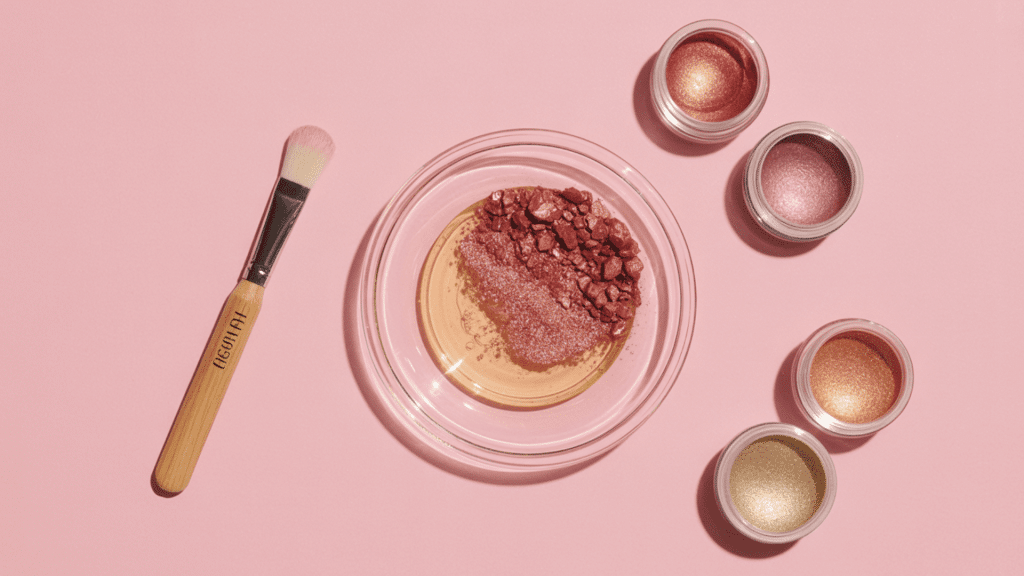
If someone likes color or shimmer, they can pre-mix a pinch of mica pigment with a drop of oil before adding it to their blend. This prevents clumping and ensures even dispersion.
Keep pigment amounts low (0.2–0.5%) for a smooth, non-gritty feel that gives just a hint of tint.
Step 5: Rest and De-Bubble
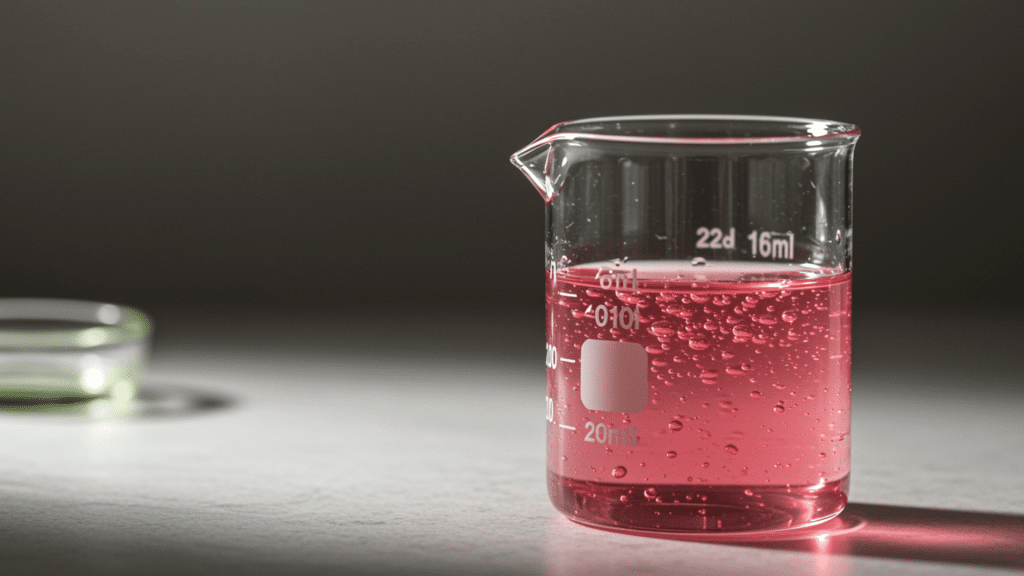
Let the mixture sit for about 5–10 minutes. This resting time allows tiny air bubbles created during mixing to rise to the surface and pop naturally.
Skipping this step can result in a cloudy or uneven appearance of finished lip oil once it’s poured into the tube.
Step 6: Fill the Tube
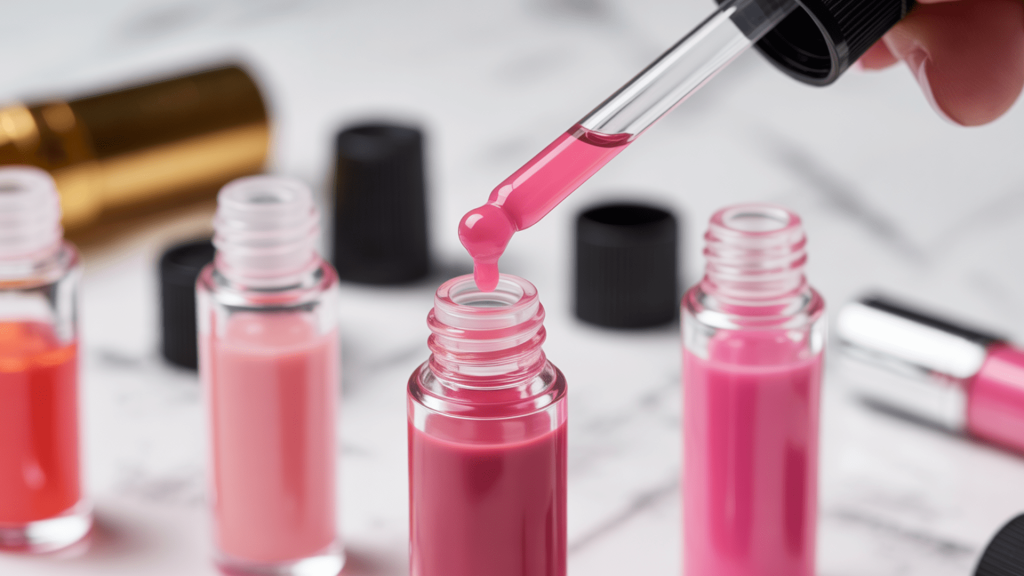
Using a pipette or small funnel, carefully transfer the finished mixture into the gloss tube.
Avoid overfilling to prevent spills when inserting the wand. Seal tightly, then wipe away any excess oil on the outside. Label the tube with the date and formula for easy tracking.
With these steps complete, a personalized lip oil is ready to use fresh, glossy, and structured exactly to one’s preferences.
Smart Swaps to Customize Lip Oils
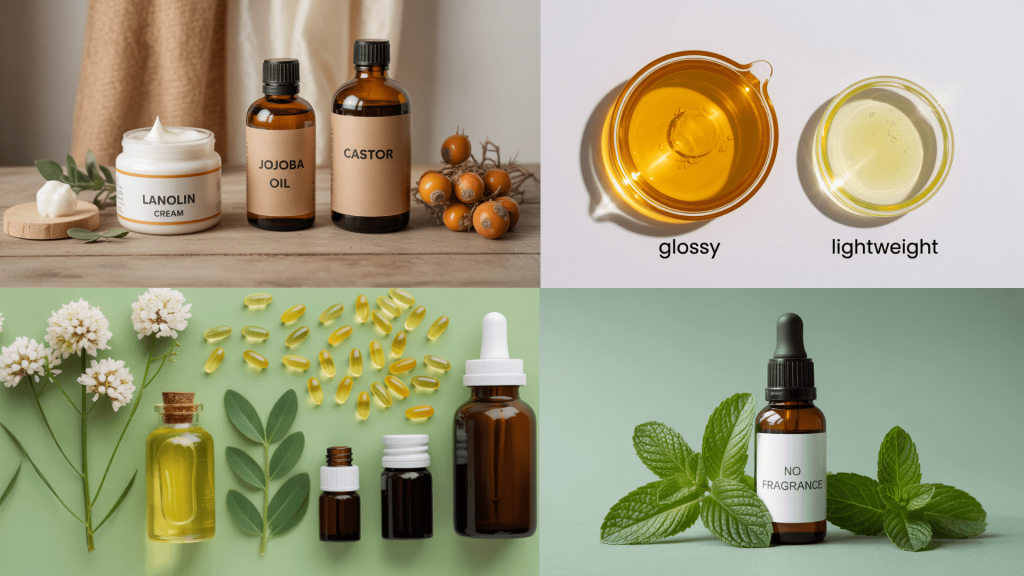
One of the best parts of DIY beauty is personalization, and lip oil can be easily adapted for different lifestyles, preferences, and sensitivities.
1. Nut-Free Alternatives
For individuals with nut allergies, almond or argan oil can be replaced with sunflower, rice bran, or grapeseed oil. These lighter oils still nourish and soften lips, while remaining allergen-safe.
They also blend seamlessly with thicker oils, making them ideal for sensitive or family-friendly DIY formulas.
2. Vegan and Non-Vegan Additions
Some makers prefer adding 2–5% lanolin for extra cushion and long-lasting moisture. While lanolin delivers a balmy, protective texture, it is not suitable for vegans.
A plant-based approach utilizes rich oils, such as castor or jojoba, which produce similar results without compromising a vegan lifestyle or ingredient preferences.
3. Fragrance-Free Options
For sensitive lips or fragrance-free routines, flavor oils can be skipped entirely. The result is a neutral, skin-friendly product that works for anyone.
If a hint of freshness is desired, a very small amount of peppermint essential oil may be added, though patch testing is recommended.
4. Glossy or Lightweight Finish
Those who enjoy a thicker gloss can increase castor oil by 5–10%, creating a shinier, longer-lasting finish.
For a silky, weightless feel, castor oil can be reduced and replaced with oils such as squalane or fractionated coconut oil, which provide slip without stickiness.
5. Extra Protection and Stability
To improve stability and extend shelf life, adding meadowfoam seed oil or vitamin E is highly effective. Meadowfoam helps resist rancidity while offering a cushiony feel.
Vitamin E, as an antioxidant, not only protects the oils but also conditions lips, ensuring the product remains fresh longer.
With these swaps, every maker can create a formula that feels uniquely theirs, from allergen-free to glossy or feather-light finishes.
Other Lip Oil Variations to Try
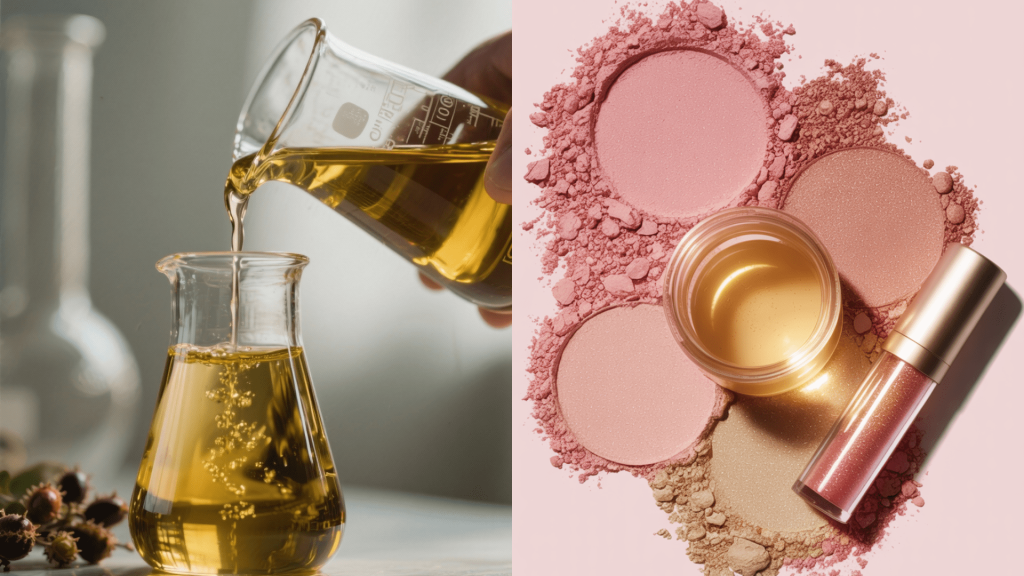
For those who enjoy experimenting, here are three simple variations that demonstrate how easily a basic formula can be modified into different textures and finishes.
1. Ultra-Lightweight “Serum Oil” Version
- Combines hemp seed oil and squalane for a feather-light texture.
- Absorbs quickly and feels almost weightless on the lips.
- Great for daytime wear or layering under lipstick.
- Offers subtle hydration without a greasy finish.
2. Overnight Lip Repair Oil
- Uses rosehip oil, avocado oil, and vitamin E for deep repair.
- Creates a thicker, richer barrier to heal cracked lips overnight.
- Locks in moisture while you sleep for softer lips by morning.
- Works well as an intensive treatment during the winter months.
- It can double as a lip mask under a balm.
3. SPF Lip Oil
- Base blend of jojoba, castor, and meadowfoam oils.
- Add lip-safe mineral SPF (like zinc oxide) or raspberry seed oil for UV support.
- Protects lips from sun damage while hydrating.
- Perfect for daytime outdoor activities.
- Lightweight enough to wear under other lip products.
4. Herbal-Infused Lip Oil
- Infuse your base oil with calendula, chamomile, or green tea leaves.
- Calms sensitive or irritated lips naturally.
- Adds antioxidants and extra healing benefits.
- Offers a subtle herbal aroma without added fragrance.
- Looks visually appealing if herbs are infused in a clear oil.
5. Honey Glow Lip Oil
- Blend sunflower oil, castor oil, and a touch of lip-safe honey extract.
- Adds a soft golden glow and subtle sweetness.
- Provides a cushiony feel with extra moisture retention.
- Creates a natural, plump look perfect for daytime wear.
- Works as a luxe, indulgent treatment for very dry lips.
6. Floral Scented Lip Oil
- Combine rosehip oil with evening primrose oil and a drop of rose or lavender essence.
- Delivers a spa-like floral aroma while conditioning lips.
- Rich in antioxidants that improve long-term lip health.
- Feels elegant and pampering with each application.
- Doubles as a lightweight lip primer under color.
These variations prove that lip oil can be as diverse as any beauty product, shifting from subtle and lightweight to bold and glossy with just a few changes.
Difference Between Lip Oil and Lip Gloss
| Aspect | Lip Oil | Lip Gloss |
|---|---|---|
| Formulation | Made with nourishing plant oils like jojoba and castor oil. | Made with synthetic bases, polymers, and adhesive ingredients. |
| Purpose | Skincare-first approach; hydrates and nourishes lips. | Cosmetic-first approach; improves shine, color, and shimmer. |
| Absorption | Lightweight formula absorbs into lips, delivering moisture from within. | Sits on top of the lips without absorption. |
| Texture | Weightless, non-sticky, and smooth. | Thicker, more viscous, sometimes sticky. |
| Finish | Subtle, natural-looking shine. | Bold, mirror-like, high-shine reflection. |
| Benefit Focus | Prioritizes long-term lip health and continuous nourishment. | Prioritizes immediate visual impact with color payoff and shimmer. |
Top Natural Lip Oils Worth Trying
Looking for a lip oil that already ticks all the boxes?
I’ve rounded up some of the most loved, naturally formulated lip oils on the market, each one chosen for its ability to hydrate, nourish, and add a touch of effortless shine.
1. Summer Fridays Dream Lip Oil
This plush, vegan lip oil combines multiple plant-based oils to hydrate and protect. It offers a glossy look with a hint of tint, giving lips both care and a subtle cosmetic bloom.
- Price: $26
- Net Quantity: 0.15 fl oz / 4.5 mL
- Ingredients: castor seed oil, rosehip oil, shea oil, avocado oil, apricot kernel oil, jojoba seed oil, squalane, grape seed oil, raspberry seed oil, collagen, and vitamin E, delivering hydration, antioxidants, and a conditioning shine
2. Rare Beauty Soft Pinch Tinted Lip Oil
A gel-to-oil hybrid that starts as a glossy tint and settles into a lightweight oil. It nourishes lips with plant oils while adding a comfortable wash of color.
- Price: $22
- Net Quantity: 0.10 fl oz / 3 mL
- Ingredients: jojoba seed oil, sunflower seed oil, squalane, glycerin, and botanical extracts (lotus, gardenia, water lily), providing hydration, antioxidant protection, and a smooth, conditioning finish.
3. Stila Heaven’s Dew Gel Lip Oil
This hybrid formula combines the shine of gloss with the nourishment of oil. With jojoba oil and hyaluronic acid, it leaves the lips looking plump and hydrated without feeling heavy.
- Price: $24
- Net Quantity: 0.18 fl oz / 5.35 mL
- Ingredients: meadowfoam seed oil, camellia seed oil, black cumin seed oil, jojoba seed oil, vitamin E, and sodium hyaluronate for hydration and lip care.
4. Clarins Lip Comfort Oil
A long-standing favorite, this oil uses jojoba, hazelnut, and sweetbriar rose oils for hydration and shine. It offers a mirror-like finish while naturally caring for your lips.
- Price: $30
- Net Quantity: 0.2 oz / 7 ml
- Ingredients: jojoba seed oil, rosehip seed oil, hazel seed oil, castor oil, caprylic/capric triglyceride, and vitamin E, with added fragrance and color pigments for tint and scent.
5. Guerlain KissKiss Bee Glow Oil
A luxury lip oil with honey and natural-origin ingredients, designed to plump, hydrate, and deliver a glassy tinted finish. It’s skincare-driven but indulgent in look and feel.
- Price: $39
- Net Quantity: 9.5 mL
- Ingredients: squalane, sunflower seed oil, rosehip oil, honey, propolis extract, royal jelly, vitamin E, and vitamin C derivative, supported by natural emollients and botanical extracts for hydration and lip care.
Whether seeking clean, everyday hydration or a luxurious, glossy finish, these lip oils prove that natural formulations can deliver both beauty and care in one product.
Final Thoughts
When I first learned how to make lip oil at home, it completely changed my lip care routine.
By mixing simple, nourishing oils like jojoba, castor, and squalane, I could customize the texture and finish exactly to my liking, and you can do the same.
Creating your own blend not only saves money compared to store-bought products but also gives you full control over every ingredient.
If you want a lightweight daytime oil or a rich, glossy evening look, lip oil adapts beautifully without the sticky feel of traditional glosses.

